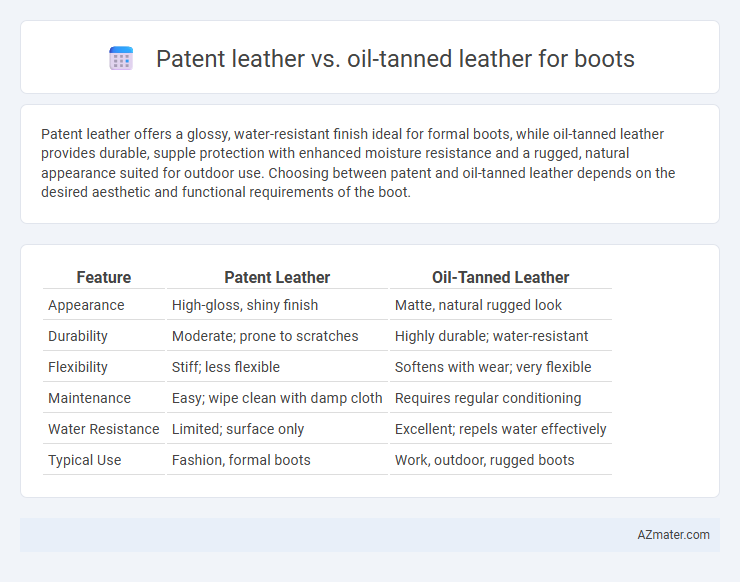Patent leather offers a glossy, water-resistant finish ideal for formal boots, while oil-tanned leather provides durable, supple protection with enhanced moisture resistance and a rugged, natural appearance suited for outdoor use. Choosing between patent and oil-tanned leather depends on the desired aesthetic and functional requirements of the boot.
Table of Comparison
| Feature | Patent Leather | Oil-Tanned Leather |
|---|---|---|
| Appearance | High-gloss, shiny finish | Matte, natural rugged look |
| Durability | Moderate; prone to scratches | Highly durable; water-resistant |
| Flexibility | Stiff; less flexible | Softens with wear; very flexible |
| Maintenance | Easy; wipe clean with damp cloth | Requires regular conditioning |
| Water Resistance | Limited; surface only | Excellent; repels water effectively |
| Typical Use | Fashion, formal boots | Work, outdoor, rugged boots |
Overview: Patent Leather vs Oil-Tanned Leather
Patent leather features a glossy, smooth surface created by applying a lacquer or varnish finish, making it highly water-resistant but less breathable. Oil-tanned leather is treated with oils to enhance its durability, flexibility, and water repellency while maintaining a matte, rugged texture ideal for boots. Both materials offer distinct advantages: patent leather excels in formal aesthetics, whereas oil-tanned leather provides superior comfort and toughness for outdoor use.
Key Characteristics of Patent Leather
Patent leather features a high-gloss, mirror-like finish achieved through a coating process that enhances water resistance and makes it easy to clean. Its smooth, shiny surface contrasts with the matte, rugged texture of oil-tanned leather, which is prized for durability and water repellency but requires more maintenance. Patent leather is less flexible and more prone to cracking under heavy use, making it ideal for fashion boots rather than work or outdoor boots.
Key Characteristics of Oil-Tanned Leather
Oil-tanned leather for boots is characterized by its durability, water resistance, and supple texture, making it ideal for rugged outdoor use and long-lasting wear. Unlike patent leather, which has a glossy, smooth finish, oil-tanned leather maintains a more natural, matte appearance with enhanced flexibility and breathability. Its rich oils penetrate deep into the hide, providing excellent protection against moisture while developing a unique patina over time.
Visual Differences: Gloss vs Matte Finish
Patent leather exhibits a highly reflective, glossy finish that enhances the boot's sleek and polished appearance. Oil-tanned leather offers a matte, natural look with subtle variations in texture and color, giving each boot a unique, rustic character. The contrast between patent leather's mirror-like shine and oil-tanned leather's subdued, organic surface defines their distinctive visual appeal.
Durability and Longevity Comparison
Patent leather offers a glossy, water-resistant finish but is prone to cracking and scuffing over time, reducing its durability compared to oil-tanned leather. Oil-tanned leather is treated with oils and waxes, enhancing its flexibility, resistance to wear, and longevity, making it ideal for boots subjected to harsh conditions. For long-lasting durability, oil-tanned leather outperforms patent leather by maintaining strength and appearance through extensive use.
Comfort and Break-in Period
Patent leather boots offer a smooth, glossy finish with minimal stretch, resulting in a longer break-in period and a stiffer initial feel that may affect comfort. Oil-tanned leather is softer and more pliable, allowing better breathability and quicker molding to the foot, which enhances comfort during extended wear. The natural oils in oil-tanned leather reduce stiffness, leading to a shorter break-in time and improved flexibility compared to patent leather.
Maintenance and Care Requirements
Patent leather boots require regular wiping with a damp cloth and occasional polishing to maintain their glossy finish, while avoiding harsh chemicals that could dull the shine. Oil-tanned leather boots demand more intensive care, including periodic conditioning with oil-based products to keep the leather supple and prevent cracking under heavy use. Both types benefit from proper storage away from direct sunlight and moisture to extend durability and preserve appearance.
Weather Resistance: Water and Stain Protection
Patent leather offers superior water resistance due to its glossy, sealed surface that effectively repels moisture and stains, making it ideal for wet conditions. Oil-tanned leather provides durable water resistance as its oils create a natural barrier that enhances flexibility and repels water, but it may require regular maintenance to retain stain protection. Both materials protect boots against weather elements, with patent leather excelling in stain prevention while oil-tanned leather offers robust long-term water resistance and breathability.
Style and Versatility in Fashion
Patent leather offers a glossy, polished finish ideal for formal and dressy boot styles, enhancing sleek and sophisticated looks. Oil-tanned leather features a matte, rugged appearance with natural texture variations, providing durability and a versatile aesthetic suitable for casual, outdoor, and urban fashion. The choice between patent and oil-tanned leather boots hinges on desired style impact and adaptability across different fashion settings.
Choosing the Right Leather for Your Boots
Patent leather offers a glossy, smooth finish ideal for formal boots, while oil-tanned leather provides durable, water-resistant qualities suited for rugged, everyday wear. Oil-tanned leather develops a unique patina over time, enhancing its appearance and longevity, making it a practical choice for outdoor activities. Choosing the right leather depends on the intended use, balancing style preferences with durability and maintenance requirements.

Infographic: Patent leather vs Oil-tanned leather for Boot
 azmater.com
azmater.com